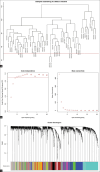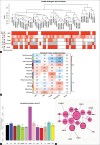Analysis of Human Papillomavirus-Associated Cervical Cancer Differentially Expressed Genes and Identification of Prognostic Factors using Integrated Bioinformatics Approaches
- PMID: 39512411
- PMCID: PMC11542694
- DOI: 10.4103/abr.abr_338_23
Analysis of Human Papillomavirus-Associated Cervical Cancer Differentially Expressed Genes and Identification of Prognostic Factors using Integrated Bioinformatics Approaches
Abstract
Background: Human papillomavirus (HPV)-induced cervical cancer progresses through a series of steps. Despite our limited understanding of the mechanisms driving this progression, identifying the key genes involved could significantly improve early detection and treatment.
Materials and methods: Two gene expression profiles of GSE9750 and GSE6791, which included cervical cancer HPV-positive and -negative samples, were evaluated using the R limma package with established cut-off criteria of P value < 0.05 and | fold change| ≥ 1. KEGG pathway enrichment was performed to identify potential pathways. Weighted gene co-expression network analysis (WGCNA) was used to discover co-expressed gene modules and trait-module connections.
Results: Considering the defined criteria, 115 differentially expressed genes (DEGs) were identified. The DEG's KEGG pathway enrichment analysis revealed enrichment in highly relevant pathways to the HPV infection, including cell cycle, viral carcinogenesis, autophagy-animal, Epstein-Barr virus infection, human T-cell leukemia virus 1 infection, and microRNAs in cancer. WGCNA results in 13 co-expression modules, and the magenta module is identified with significant relations to HPV, cervical cancer stage, and metastasis traits. The survival analysis identified BEX1 and CDC45 as potential prognostic factors in HPV-associated cervical cancer.
Conclusion: The innovation of our work lies in identifying essential genes associated with the multi-step process of cervical carcinogenesis. In fact, the current study has the potential to give a distinct viewpoint on the molecular pathways linked to cervical cancer. Considering the potential importance of the hub genes, we recommend conducting in-depth wet lab research to determine their impact on the biological mechanisms of cervical cancer.
Keywords: BEX1; CDC45; HPV; cell cycle; cervical cancer; gene expression; gene modules; gene networks.
Copyright: © 2024 Advanced Biomedical Research.
Conflict of interest statement
There are no conflicts of interest.
Figures






Similar articles
-
Comprehensive analysis of lncRNA-mRNA co-expression networks in HPV-driven cervical cancer reveals the pivotal function of LINC00511-PGK1 in tumorigenesis.Comput Biol Med. 2023 Jun;159:106943. doi: 10.1016/j.compbiomed.2023.106943. Epub 2023 Apr 20. Comput Biol Med. 2023. PMID: 37099974
-
Bioinformatics Analysis Highlights Five Differentially Expressed Genes as Prognostic Biomarkers of Cervical Cancer and Novel Option for Anticancer Treatment.Front Cell Infect Microbiol. 2022 Jun 17;12:926348. doi: 10.3389/fcimb.2022.926348. eCollection 2022. Front Cell Infect Microbiol. 2022. PMID: 35782114 Free PMC article.
-
Investigation of differentially-expressed microRNAs and genes in cervical cancer using an integrated bioinformatics analysis.Oncol Lett. 2017 Apr;13(4):2784-2790. doi: 10.3892/ol.2017.5766. Epub 2017 Feb 22. Oncol Lett. 2017. PMID: 28454467 Free PMC article.
-
Decoding dysregulated genes, molecular pathways and microRNAs involved in cervical cancer.J Gene Med. 2024 Jul;26(7):e3713. doi: 10.1002/jgm.3713. J Gene Med. 2024. PMID: 38949075
-
Construction of Gene Modules and Analysis of Prognostic Biomarkers for Cervical Cancer by Weighted Gene Co-Expression Network Analysis.Front Oncol. 2021 Mar 18;11:542063. doi: 10.3389/fonc.2021.542063. eCollection 2021. Front Oncol. 2021. PMID: 33816217 Free PMC article.
References
-
- Ferlay J, Colombet M, Soerjomataram I, Mathers C, Parkin DM, Piñeros M, et al. Estimating the global cancer incidence and mortality in 2018: GLOBOCAN sources and methods. Int J cancer. 2019;144:1941–53.. - PubMed
-
- Schiffman M, Doorbar J, Wentzensen N, De Sanjosé S, Fakhry C, Monk BJ, Stanley MA, Franceschi S. Carcinogenic human papillomavirus infection. Nat Rev Dis Prim. 2016;2:1–20.. - PubMed
-
- Walboomers JMM, Jacobs MV, Manos MM, Bosch FX, Kummer JA, Shah K V, Snijders P J, Peto J, Meijer C J, Muñoz N. Human papillomavirus is a necessary cause of invasive cervical cancer worldwide. J Pathol. 1999;189:12–9.. - PubMed
LinkOut - more resources
Full Text Sources
Miscellaneous
